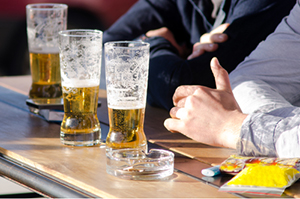 Like a lot of people, you might be heeding the widely-touted advice to consume moderate amounts of red wine for the sake of your heart.
Like a lot of people, you might be heeding the widely-touted advice to consume moderate amounts of red wine for the sake of your heart.
But can alcohol affect arthritis?
As it turns out, what types of alcoholic beverages you choose to imbibe can, indeed, influence your joint health. Moreover, scientists are finding associations, both beneficial and detrimental, between types of alcoholic beverages and particular forms of arthritis.
Today we’ll discuss three types of arthritis and how a different types of alcohol affects them. The types are Rheumatoid Arthritis, Gout, and Osteoarthritis
Rheumatoid Arthritis
Grapes are famous for their high levels of resveratrol, a potent antioxidant thought to help prevent heart disease and some forms of cancer. As it turns out, resveratrol might also improve joint health. In a preliminary study on mice, resveratrol inhibited two types of white blood cells associated with RA. The mice also showed lower levels of inflammation and less bone erosion.
A compound in grapes known as gallic acid, a type of phenolic antioxidant, has the power to cut inflammation off at the knees, according to results of one study. Researchers say it does this by inhibiting the expression of pro-inflammatory genes. They also note that gallic acid promotes early death of certain joint cells when they begin to behave badly in rheumatoid arthritis (RA) patients.
When rheumatoid-affected cells were treated with gallic acid, the cells weakened and died. Levels of inflammatory markers and tissue-degrading enzymes also decreased following gallic acid treatment.
The Nurses’ Health Study, a decades-long study involving more than 200,000 U.S. nurses, determined that moderate alcohol consumption can offer protection against RA. Participants who tested positive for RA blood markers showed even greater benefits. Beer drinkers also fared well with women in the study who drank beer 2-4 times per week showing 31% decreased risk of developing the disease.
Gout
If you have gout or if you are prone to developing gout you might, however, want to steer clear of beer, according to the information published in the Third National Health and Nutrition Examination Survey.
The study, which questioned nearly 15,000 participants on their beer, liquor and wine consumption and compared that data with their uric acid levels, found that beer and hard liquor were associated with increased uric acid levels, with beer showing a greater detrimental effect, while wine consumption did not seem to increase uric acid levels.
Another study sought to clear up anecdotal evidence that wine may act as a trigger for gout flare-ups and found that, indeed, wine, beer, and liquor were all associated with increased risk of gout attacks. The risk was 1.36 times higher for moderate consumption – anything more than 1-2 drinks in a 24-hour period – and 1.51 times higher for more than 2-4 drinks in a 24-hour period.
So if you suffer gout, you should just stay away from any type of alcohol.
Osteoarthritis
It’s not an autoimmune disease like RA or a metabolic problem, as in gout; rather, osteoarthritis (OA) is your garden-variety worn-out joint disease.
However, your alcohol drinking habits may play a role in whether you develop OA.
A study on the possible connection between alcohol consumption and OA of the knee and hip found that wine drinking actually provided protective effects while beer drinkers in the study showed increased risk, providing another good reason to eschew the trendy local microbrewery fare and, instead, explore the offerings at your favorite neighborhood wine bar.

 Overcoming IBD
Overcoming IBD Multiple Sclerosis
Multiple Sclerosis Banishing Bronchitis
Banishing Bronchitis Gum Disease Gone
Gum Disease Gone Overcoming Onychomycosis
Overcoming Onychomycosis Neuropathy No More
Neuropathy No More The Prostate Protocol
The Prostate Protocol Brain Booster
Brain Booster
 Ironbound
Ironbound
 Solution for Shingles
Solution for Shingles
 The Bone Density Solution
The Bone Density Solution
 The Ultimate Healing Protocol
The Ultimate Healing Protocol
 The Parkinson's Protocol
The Parkinson's Protocol
 The Chronic Kidney Disease Solution
The Chronic Kidney Disease Solution
 Overthrowing Anxiety
Overthrowing Anxiety The Fatty Liver Solution
The Fatty Liver Solution The Hypothyroidism Solution
The Hypothyroidism Solution
 The End of Gout
The End of Gout The Blood Pressure Program
The Blood Pressure Program
 The Oxigized Cholesterol Strategy
The Oxigized Cholesterol Strategy
 Stop Snoring And Sleep Apnea Program
Stop Snoring And Sleep Apnea Program
 The Arthritis Strategy
The Arthritis Strategy The Vertigo & Dizziness Program
The Vertigo & Dizziness Program The 3-Step Diabetes Strategy
The 3-Step Diabetes Strategy Hemorrhoids Healing Protocol
Hemorrhoids Healing Protocol The Erectile Dysfunction Master
The Erectile Dysfunction Master Weight Loss Breeze
Weight Loss Breeze The IBS Program
The IBS Program The Insomnia Program
The Insomnia Program The Migraine and Headache Program
The Migraine and Headache Program The Neck Pain Solution
The Neck Pain Solution The Menopause Solution
The Menopause Solution The Ejaculation Master
The Ejaculation Master The TMJ Solution
The TMJ Solution The Acid Reflux Solution
The Acid Reflux Solution The Fibromyalgia Solution
The Fibromyalgia Solution The Psoriasis Strategy
The Psoriasis Strategy
Informative
I'm 72 years old and have to work to supplement my Social Security. By the end of the day my body and the stress of living with pain all day are greatly alleviated by drinking a couples glasses of red wine. Wine is a pain and stress reliever and it doesn't have the adverse effects common with all drugs which are in fact chemicals.
A little Port after dinner is my favorite, it tastes real good and contains
something called resveratrol which I understand is good for me so bottom up.